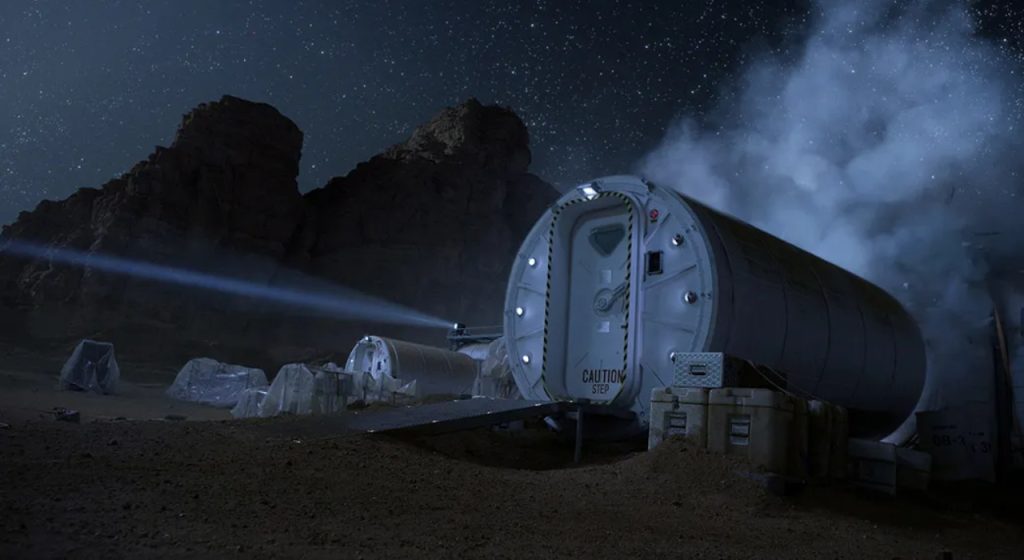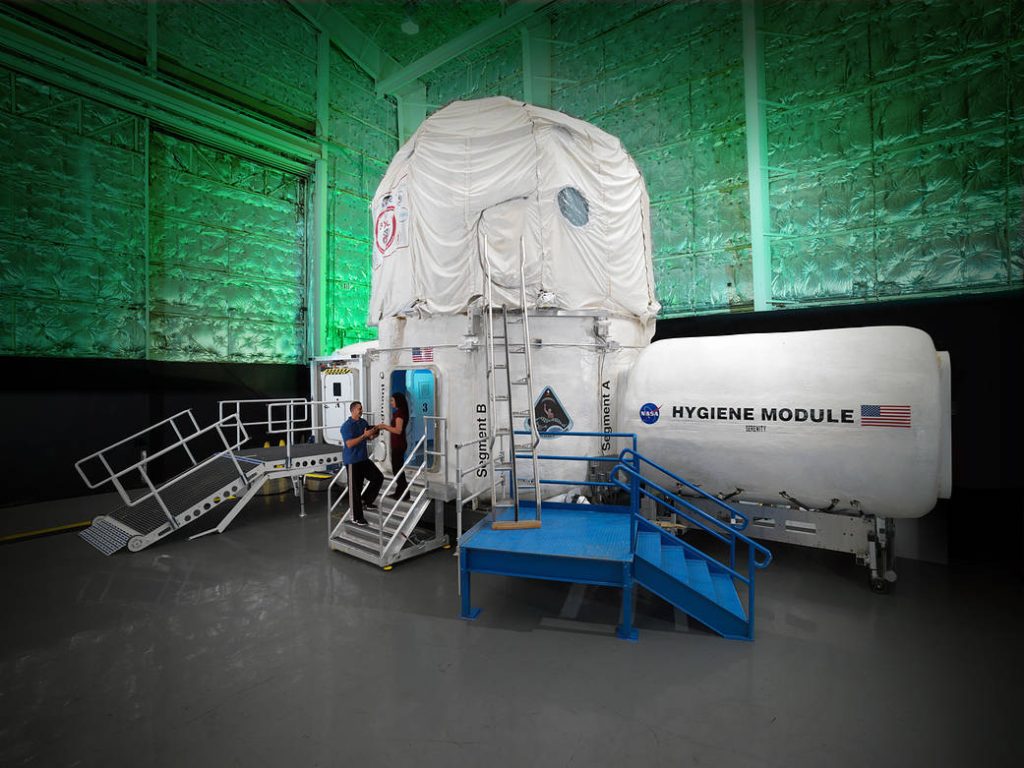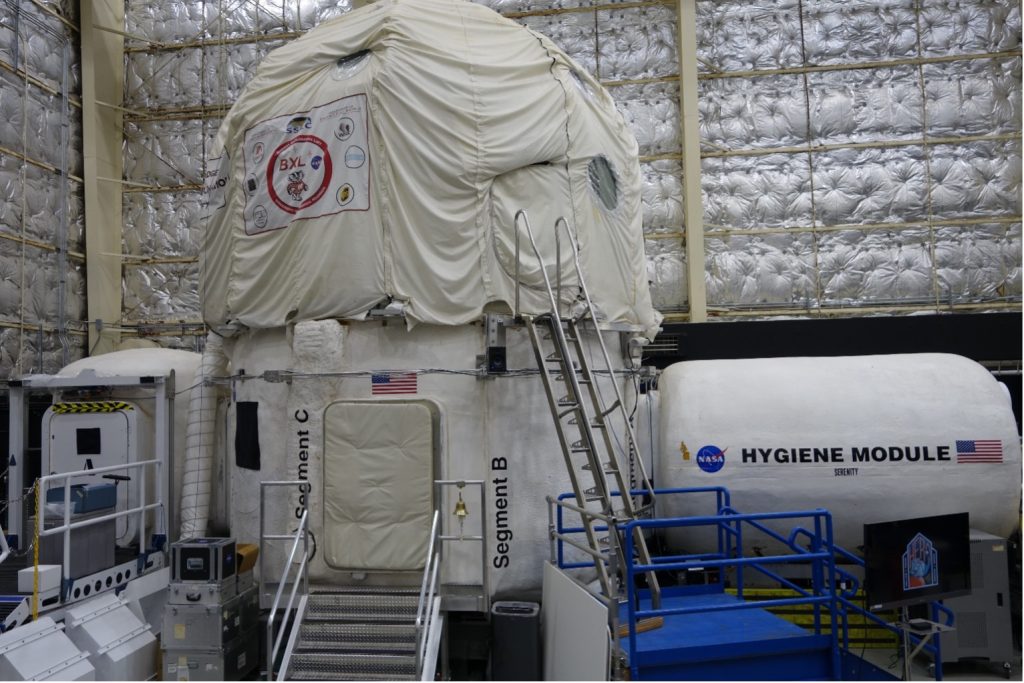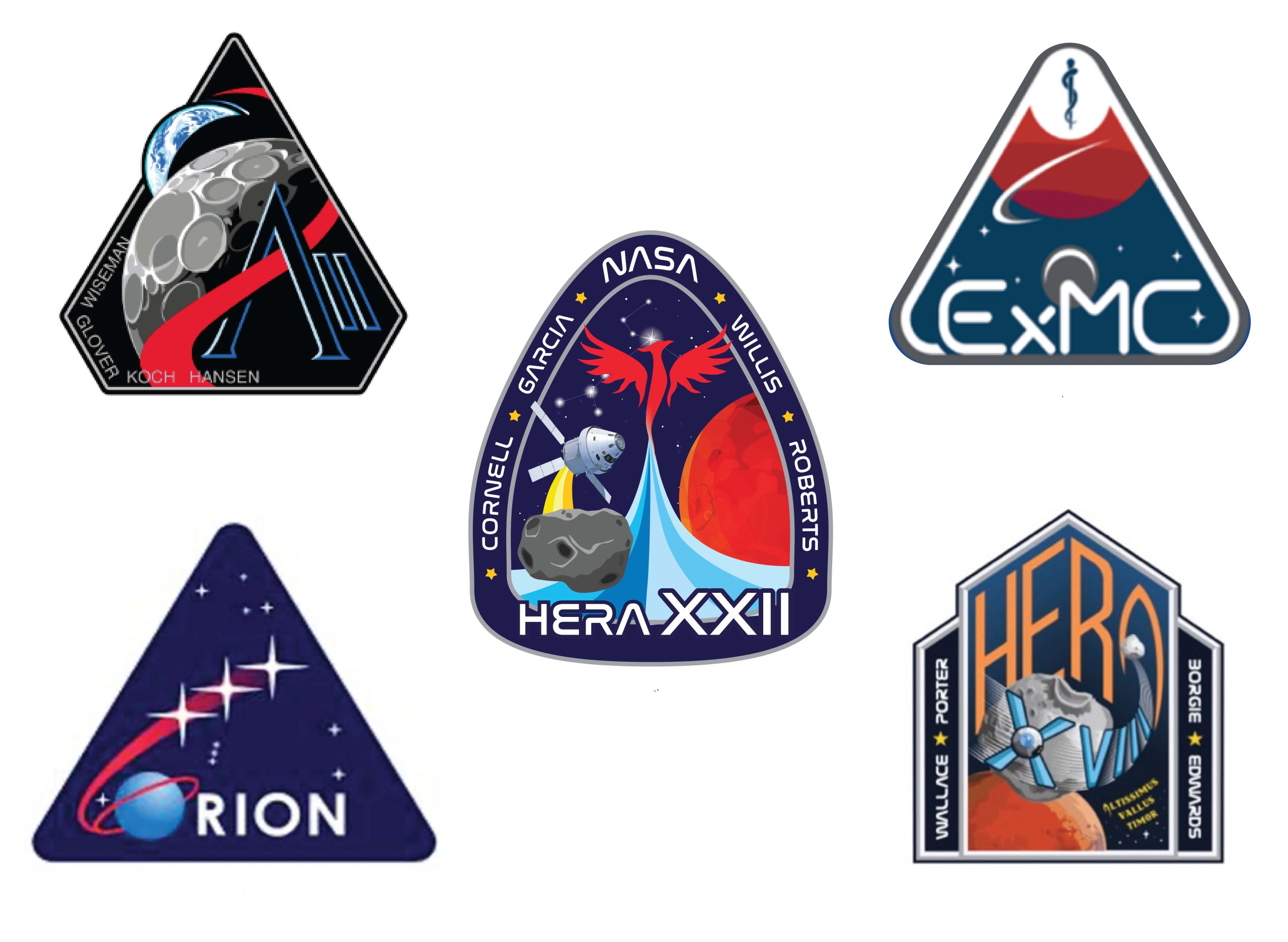Home » Education Programs » Innovation Gateway » HERA Patch Challenge
NASA, in collaboration with Space Center Houston, is calling on students to create a graphical patch that represents the goals of HERA’s Campaign 8 missions.

HERA is a two-and-a-half story, 650-square-foot habitat at NASA’s Johnson Space Center in Houston. The facility simulates the type of isolation, confinement, and remote conditions that astronauts will experience on deep space missions.
Beginning in 2026, four missions will take place inside HERA, all simulating a trip to the Moon. Each will have four volunteer crew members who live isolated and confined within HERA for 45 days. Research volunteers live and work like astronauts during the missions, carrying out maintenance, operational, and scientific tasks. They will also experience simulated communication delays with HERA’s Mission Control Center. Scientists assess how the environment affects the mental and physical health of participants. Resulting data helps NASA plan future human expeditions to the Moon, Mars, and beyond.

The Human Exploration Research Analog, located at NASA’s Johnson Space Center in Houston / Credit: NASA
The challenge is open to students from public and private schools in the United States who will be in grades K-12 during the 2025-2026 academic year. Winners will be chosen from three age categories: Grades K-4, grades 5-8, and grades 9-12. A grand prize winner will be selected from the category winners.
Patch designs can be submitted individually or as a class project, with one design per submission. Acceptable file formats include .jpg, .jpeg, .png, .pdf, and .doc. Designs should be submitted to Space Center Houston through the link below.
HERA managers will select the winning designs and notify the winners before the end of the 2025 calendar year.
Winners in each age category will receive a virtual tour of the HERA facility.
The grand prize winner will have the opportunity to collaborate with a professional NASA graphic designer to finalize their design.
This design will be prominently displayed on the HERA facility during all four Campaign 8 missions, which will take place in 2026 and 2027.

What are we looking for in a HERA patch design? To guide you, here are some examples of successful patches that have been used by NASA and HERA.
Below: A collection of graphic identifiers used within NASA and HERA. a) the new Artemis II mission patch; b) a patch representing a group formerly within the Human Research Program that focused on exploration medical capabilities; c) the HERA mission patch for Campaign 6 Mission 1; d) a patch representing the NASA Orion spacecraft; e) the mission patch for HERA’s Campaign 5 Mission 1.

The new Artemis II mission patch.
A patch representing a group formerly within the Human Research Program that focused on exploration medical capabilities.
Spaceflight analogs are any environment that produces the same or similar effects on humans as is experienced in actual spaceflight. NASA uses “analogs” to represent different aspects of spaceflight here on Earth. The Human Exploration Research Analog (HERA) at the Johnson Space Center in Houston, Texas, is an analog for the isolated and confined living environment of a long-duration spaceflight mission, such as a mission to Mars.
Isolation and Confinement is one of the five identified risk categories. Researchers use the HERA to study how individuals and teams perform, interact, and maintain health during extended periods of isolation in a small volume with little privacy and variable workloads, which can increase stress. Each HERA campaign consists of four identical missions with four crewmembers per mission. Lasting 45-days, each mission simulates transit to/from Mars plus a short period of orbital operations around Mars.
What should I know about the HERA habitat?
The HERA habitat is about the size of a one-bedroom apartment with a small kitchen/galley, a multi-use table for dining, entertainment, and working, a bathroom, four sleeping bunks, exercise space, a small airlock, and laboratory/workspace.
The crews stay busy from 7 a.m. to 7 p.m. most days as they perform science experiments, robotics and Extra Vehicular Activity (EVA) simulations, habitat systems maintenance and housekeeping, exercise, and research data and biological sample collections.
The mission also includes simulating a delay in communication with the Earth-based Mission Control Center (MCC) that increases the closer they get to Mars, with a maximum of five minutes for radio calls to reach MCC (10-minute roundtrip). On a real Mars mission, communication delays could be up to 22 minutes one-way depending on Mars’ position in orbit relative to Earth.
HERA Campaign 8 involves a simulated mission to Earth’s Moon. While crews are on their missions, they will be test subjects for several scientific studies that are being carefully developed by researchers from NASA and universities across the United States.
Studies within HERA will focus on the following themes:
We recently celebrated the 50th anniversary of Apollo 11, landing the first human on the surface of the moon. Following Apollo was the Space Shuttle program with the primary goal of constructing the International Space Station where crews have been working and living in space since 2000. Our new program, Artemis, is named for the goddess of the moon in Greek mythology. Artemis is also the twin sister of Apollo. With Artemis we will venture beyond Low Earth Orbit, establish a sustainable presence on the moon and prepare for a journey to Mars.
The environment of space presents numerous challenges to human travelers. Exploration class missions will expose crews to a variety of hazards which NASA has identified and grouped into five primary categories including: changes in gravity fields, radiation, hostile environments, isolation and confinement, and distance from Earth. To venture beyond Low Earth Orbit, we must understand these risks to human physiology and develop methods to protect our most precious cargo – our crew.
To advance the goals of human space exploration, NASA continuously addresses the problem of keeping astronauts healthy in the closed environment of a space vehicle and surface habitats by developing innovative practices and technologies. Although we have gained an incredible amount of information from living and working on the ISS, there are still many questions to be answered. Investigating these questions in space has provided invaluable information but has practical limitations.
One consideration is cost. It is currently estimated that the cost of sending one pound of cargo to space is approximately $10,000. Cargo for even simple experiments conducted on station must be limited in both mass and volume.
Another issue is time. The ISS crew schedules are packed with both conducting experiments and maintaining the ISS. In addition, the number of crew who can be studied while in space is very low. Because of these and other challenges, NASA has developed other methods, including analog studies.
Mission patches are emblems designed and worn by astronauts and people affiliated with a mission. The patches depict an image associated with the mission and generally lists the names of the crew. Every expedition to the International Space Station (ISS) has a unique patch. Mission patches have been worn by NASA astronauts since 1965. The four HERA crews will develop a patch to represent their specific mission. NASA would like to have a student-designed patch that is representative of the HERA Campaign 7 missions and objectives.
HOURS TODAY
Have them apply to Rise! Rise is a program that offers students access to scholarships, mentorship, networking and career development opportunities, fostering their ability to address pressing global challenges.
The All-American Rejects are throwing Space Center Houston’s Moon 2 Mars Festival into hyperdrive. Amp up your Space City Spring Break with us!
Access to this all-ages festival is included in general admission.
WEATHER ALERT
For the safety of our guests and staff, Space Center Houston is closed on Tuesday, January 21 and Wednesday, January 22 due to forecasted inclement weather.
We apologize for the inconvenience and look forward to welcoming you soon! For questions or concerns, contact our Reservations team with your order number at 281.283.4755 or via email.